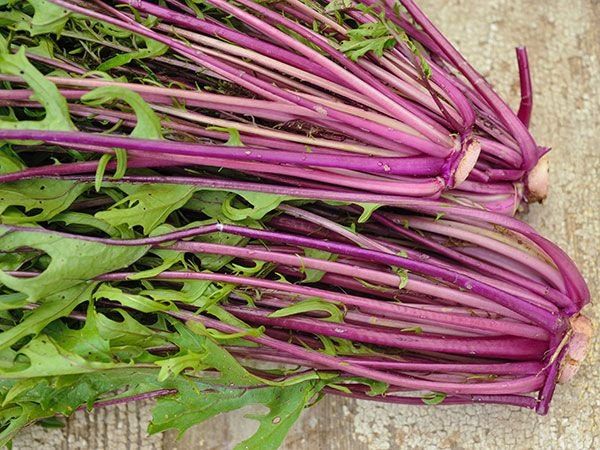Mizuna Beni Houshi is a unique and striking variety of mizuna, an Asian green in the Brassica family. With its vivid colors and delicious, peppery flavor, this heirloom vegetable makes a beautiful and tasty addition to salads, stir-fries, and other dishes.
An Overview of Mizuna
Mizuna, also known as spider mustard, Japanese mustard, or California peppergrass, has been cultivated in Japan since the mid-19th century. It features delicate, deeply serrated green leaves and crisp, white stems. There are around 16 different cultivars of mizuna, distinguished by subtle variations in color, texture, and taste
All types of mizuna are packed with nutrients like vitamin A vitamin C, calcium and iron. The leaves also contain powerful antioxidants called kaempferol and quercetin, which have anti-inflammatory and anticancer properties.
In addition to being extremely healthy, mizuna is versatile and easy to grow. It thrives in both hot and cold climates, flourishing in all parts of the United States. Mizuna can be harvested at both baby and mature stages. The young leaves work well in salads, while mature mizuna stands up to cooking in stir-fries or soups.
What Makes Mizuna Beni Houshi Special?
Beni Houshi is one of the most unique and eye-catching varieties of mizuna. It features lime green, deeply serrated leaves with vivid reddish-purple stems. This color combination makes a stunning visual impact, lending beauty and flair to any dish.
While all mizuna varieties have a pleasant, peppery bite, Beni Houshi is considered to be especially mild compared to some other cultivars. When eaten raw, the leaves have a gentle mustardy kick that is not overpowering. The stems have a pleasing crunch and sweetness.
In addition to its vibrant appearance and balanced flavor, Beni Houshi contains high levels of anthocyanins These antioxidant compounds give the stems their reddish-purple pigment and provide an array of health benefits Anthocyanins have been linked to reduced inflammation, enhanced brain function, and lower risk of cardiovascular disease.
How to Grow Mizuna Beni Houshi
Like other mizuna varieties, Beni Houshi thrives in cool weather and can withstand light frosts. It prefers sunny locations with nutrient-rich, well-drained soil. Here are some tips for successfully growing this colorful heirloom:
-
Direct sowing is recommended. Sow seeds directly in the garden 1/4 inch deep in early spring or late summer/early fall.
-
Space rows 12-18 inches apart. Thin seedlings to 6 inches apart.
-
Keep soil consistently moist, especially when plants are young. Add mulch to retain moisture.
-
Mizuna grows rapidly, ready for harvest in around 30 days as baby greens or 45-50 days at full maturity.
-
To prevent bolting, provide adequate water and use row covers or shade cloth to protect from excessive heat.
-
Harvest outer leaves as needed, taking care not to remove the inner core. This encourages continuous leaf production.
-
In hot climates, grow Beni Houshi as a cool season annual. In mild winter areas, it will last longer as a perennial.
How to Eat Mizuna Beni Houshi
One of the joys of growing mizuna Beni Houshi is finding creative ways to enjoy its lively color and flavor. Here are some serving suggestions:
-
Add young leaves raw to salads, sandwich wraps, and spring rolls. They make a peppery counterpart to mild greens.
-
Mature mizuna works well cooked in soups, stir-fries, and noodle dishes. Add at the end to briefly wilt.
-
Blanch larger leaves then chill and toss with sesame oil, rice vinegar, and toasted sesame seeds for a tasty side dish.
-
Skewer rolled mizuna leaves with meat or tofu and grill or broil. The leaves char beautifully.
-
Garnish grain bowls, omelets, fish, and other entrées with fresh Beni Houshi leaves.
-
Make a compound butter studded with minced mizuna, garlic, and lemon zest. Spread on grilled meats or fish.
-
Infuse olive oil or vinegar with chopped Beni Houshi stems and leaves. Use for salad dressings and marinades.
With its vivid hues and adaptable flavor, mizuna Beni Houshi brings an invigorating pop of color and taste to meals throughout the cooler months of the year. This beautiful heirloom variety is easy to grow and adds a nutritious, delightful kick to all kinds of dishes.
Frequency of Entities
- ‘Beni Houshi’ – 22
- mizuna – 19
- leaves – 10
- stems – 7
- flavor – 6
- varieties – 5
- purple – 4
- antioxidants – 3
- mustard – 3
- vitamin – 2
- cultivation – 2
- folate – 1
- ‘Japanese Pink’ – 0
- ‘Japanese Red Mustard’ – 0
How to Grow Mizuna: The Leafy Green You Aren’t Growing (But Should)
FAQ
What does mizuna Beni Houshi taste like?
What is Beni Houshi?
Is mizuna a lettuce?
What is the taste of mizuna?

